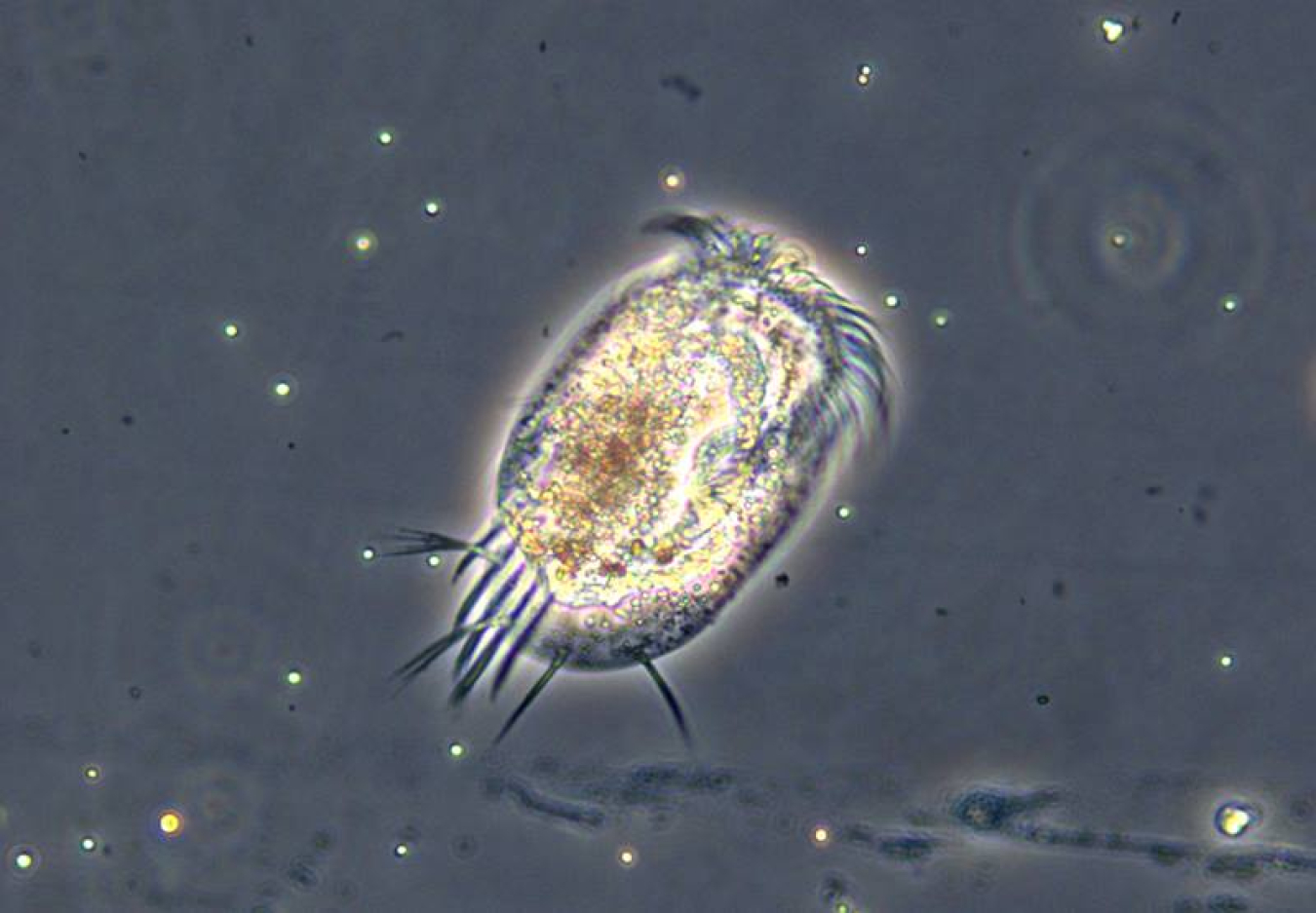Duke University scientists constructed a microbial food web to investigate how climate change and excess nutrients could affect the organisms in it.
May 23, 2024
This is the protist predator Euplotes sp. By creating a food web with this predator at the top, scientists found that changing temperature and nutrients can alter the relationship between abundance and average body sizes in microbes.
A microscopic creature may not come to mind when you think of a “peak predator.” But even microbial food webs have organisms on top. Food webs are the collections of species and their feeding interactions. While microbes are tiny, their food webs have big effects on the larger ecosystems they are part of. These food webs influence carbon cycling and storage, which in turn affects climate change and ecosystem functions.
Climate change and pollution also impact the relationships between these tiny organisms. To better understand these effects, researchers from Duke University supported by the Department of Energy’s Office of Science investigated how changes in temperature and nutrients can alter microbial food webs.
Right now, ecologists have a good handle on how temperature and nutrients separately affect microbes.
Generally, increases in temperature speed up organisms’ metabolisms. This change results in organisms needing more energy, while also getting less energy out of their food. As a result, organisms eat far more than they otherwise would. Because consumers are eating more, there are fewer plants or algae at the bottom of the food chain. This shift can result in two very different outcomes depending on the situation. In some cases, it can result in a larger population of predators. In other cases, it can lead to a smaller population of predators because they are starving. Either way, these increases in temperature make the food web less stable. Higher temperatures can also lead to smaller body sizes in individuals.
Separately, run-off from agricultural fields can increase the nutrients available to organisms. It seems like more nutrients would be a good thing. But these increases in phosphorus and nitrogen lead to algae growth. The growth can lead to algae blooms, dead zones in waterways, and fish dying from lack of oxygen. These changes destabilize food webs. Changes in nutrients can also affect body size, which further influences the population.
However, environmental changes don’t occur in isolation. Humans influence many different parts of the environment all at once.
Unfortunately, there is less information on the combined effects of temperature and nutrients. One thing scientists do know is that these effects aren’t the same as if you just simply add together the individual impacts. In some situations, the effects of each can minimize the negative impacts. For example, small increases in temperature in an ecosystem with low temperatures can offset the instability from increases in nutrients. In other situations, the combined results can drastically increase the negative effects.
To better understand these relationships, biologists at Duke University created a set of food webs in a controlled environment – the laboratory. Their watery food web had three levels. First, they started with a community of bacteria with thousands of species. They retrieved the bacteria from a pond in nearby Duke Forest. They then added a bacteria-eating protist, a type of microbe that lives in both marine and freshwater environments. To top off their food web, they added a predator protist that eats both organisms.
Once they had built their food webs, they simulated the effects of climate change and water pollution. They had four different sets of the food web that allowed them to test four different conditions. The two temperature levels were a moderate 71 degrees F and a slightly warmer 77 degrees F. To mimic levels of nutrients, they tweaked the concentration of the liquid the microbes were grown in.
After observing the microbes for 16 days, the scientists found that the different conditions had caused major changes in the relationship between the prey and predators. The effects were complex, but consistent enough that they could measure patterns.
The increases in both temperature and nutrients led to the bacteria populations growing quickly. They rapidly reached their carrying capacity, the maximum population for a habitat. In contrast, the intermediate predator’s population increased quickly but then dropped. The top predator’s population grew steadily. In addition, the increases in temperature and nutrients led to increases in body size for both of the protists.
Interestingly, the combined effects of the temperature and nutrients had major effects only on the predators. The higher up the organism was in the food web, the bigger the effect. The bacteria mainly reacted to the change in nutrients, not temperature. In contrast, the top protist predator was affected the most by the combination of the two changes. This difference happened in part because every change at the bottom levels of the food web flows to the top. Impacts from changes at the top can also flow downward, but this influence isn’t as strong.
Of the different conditions, the combination of lower nutrient levels and higher temperatures had the biggest effect on the relationships among the organisms. In this condition, changes in the population or body size of one species had the most substantial effect on the other species.
This condition also had major effects on the relationship between an organism’s body size and its population size. These results showed that the ability to shift body size may play a larger role in the food web than scientists had previously thought. The researchers hypothesized that populations of organisms may respond to increases in temperature by shifting to smaller body sizes. This smaller size may minimize the effect temperatures have on the population numbers.
Understanding these tiny food webs in the lab can provide us with insights into the big picture. Earth systems modelers can incorporate this understanding into computer simulations of our current and future ecosystems. Simulations in turn can help us understand the effects of human actions and how to minimize their negative effects. From the smallest microbes to the biggest predators, every part of every food web plays a role in our global ecological systems.
Shannon Brescher Shea

Shannon Brescher Shea (shannon.shea@science.doe.gov) is the social media manager and senior writer/editor in the Office of Science’s Office of Communications and Public Affairs. She writes and curates content for the Office of Science’s Twitter and LinkedIn accounts as well as contributes to the Department of Energy’s overall social media accounts. In addition, she writes and edits feature stories covering the Office of Science’s discovery research and manages the Science Public Outreach Community (SPOC). Previously, she was a communications specialist in the Vehicle Technologies Office in the Office of Energy Efficiency and Renewable Energy. She began at the Energy Department in 2008 as a Presidential Management Fellow. In her free time, she enjoys bicycling, gardening, writing, volunteering, and parenting two awesome kids.


